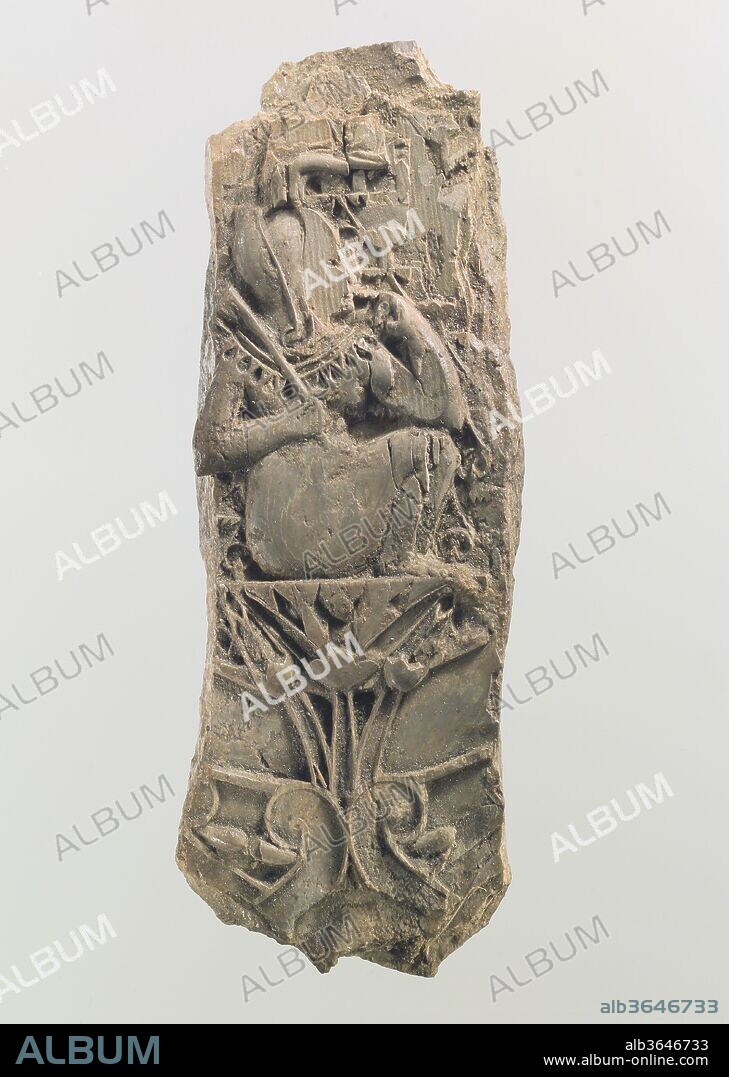alb3646733
Cloisonne furniture plaque with an infant on a lotus flower

|
Ajouter à une autre Lightbox |
|
Ajouter à une autre Lightbox |



Avez-vous déjà un compte? S'identifier
Vous n'avez pas de compte ? S'inscrire
Acheter cette image
Titre:
Cloisonne furniture plaque with an infant on a lotus flower
Légende:
Voir la traduction automatique
Cloisonne furniture plaque with an infant on a lotus flower. Culture: Assyrian. Dimensions: 4.37 x 1.54 x 0.53 in. (11.1 x 3.91 x 1.35 cm). Date: ca. 8th century B.C..
An infant sits in profile on an elaborately carved lotus flower that emerges from a double volute in this fragmentary plaque. Wearing a long robe, he presses one finger to his lips. This Egyptianizing motif, as well as the slender, flowing carving style and embellishments with the cloisonné inlay technique, are all characteristic of Phoenician artistry. Several other elements also drawn from Egyptian art include the wesekh broad collar, sidelock, and crown with a horizontal ram's horn. The motif of an infant sitting on a lotus flower is known from Egyptian art where it evokes the birth of Horus, the Egyptian sky god, and is also associated with the birth of Ra, the Egyptian sun god. This imagery became significant in the Nile Valley during the Third Intermediate Period, a time that coincided with Phoenician presence in the Levant. While the instrument held by the infant does not survive intact, it was probably the flail, an emblem of Egyptian royalty held over the shoulder that resembles the flywhisk. Another ivory plaque in the Metropolitan Museum's collection that was found at Arslan Tash in Syria shares this imagery (MMA 57.80.9).
Built by the Assyrian king Ashurnasirpal II, the palaces and storerooms of Nimrud housed thousands of pieces of carved ivory. Most of the ivories served as furniture inlays or small precious objects such as boxes. While some of them were carved in the same style as the large Assyrian reliefs lining the walls of the Northwest Palace, the majority of the ivories display images and styles related to the arts of North Syria and the Phoenician city-states. Phoenician style ivories are distinguished by their use of imagery related to Egyptian art, such as sphinxes and figures wearing pharaonic crowns, and the use of elaborate carving techniques such as openwork and colored glass inlay. North Syrian style ivories tend to depict stockier figures in more dynamic compositions, carved as solid plaques with fewer added decorative elements. However, some pieces do not fit easily into any of these three styles. Most of the ivories were probably collected by the Assyrian kings as tribute from vassal states, and as booty from conquered enemies, while some may have been manufactured in workshops at Nimrud. The ivory tusks that provided the raw material for these objects were almost certainly from African elephants, imported from lands south of Egypt, although elephants did inhabit several river valleys in Syria until they were hunted to extinction by the end of the eighth century B.C.
Technique/matériel:
MARFIL
Période:
NEOASIRIO
Musée:
Metropolitan Museum of Art, New York, USA
Crédit:
Album / Metropolitan Museum of Art, NY
Autorisations:
Modèle: Non - Propriété: Non
Questions sur les droits?
Questions sur les droits?
Taille de l'image:
2974 x 4175 px | 35.5 MB
Taille d'impression:
25.2 x 35.3 cm | 9.9 x 13.9 in (300 dpi)
Mots clés:
 Pinterest
Pinterest Twitter
Twitter Facebook
Facebook Copier le lien
Copier le lien Email
Email
